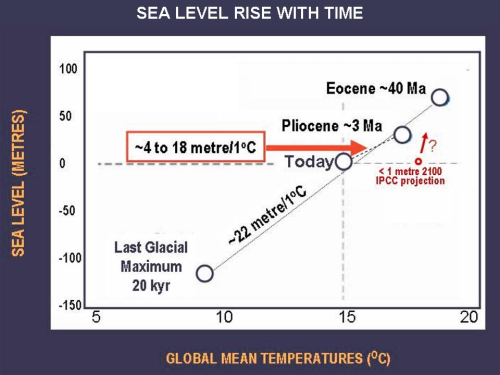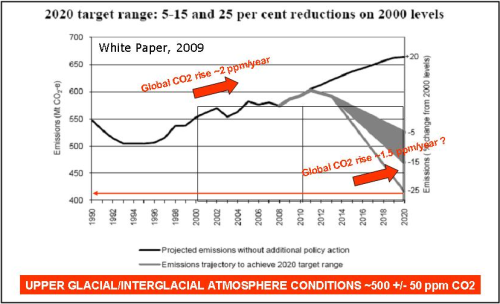Figure 1. Sea level change 1970-2008

Figure 2. Sea level change rates (after Vermeer and Rahmstorf, 2009)
Advertisement
Increasing rates of ice mass loss from the Greenland and Antarctic ice sheets revealed by GRACE satellite (Geophys. Res. Lett., 36, L19503, doi:10.1029/2009GL040222 ; DOI: 10.1126/science.326_217a ; DOI: 10.1126/ science.326.5955.926) constitute the definitive warning for Homo Sapiens. In Greenland mass ice loss increased from 137 billion ton (GtI) ice/year in 2002-2003 to 286 GtI/year in 2007-2009 (doi:10.1029/2009GL040222). In Antarctica ice mass loss increased from 104 GtI/year in 2002-2006 to 246 GtI/year in 2006-2009. According to Kerr, 2009 (DOI: 10.1126/science.326_217a) “the latest analysis of the most comprehensive, essentially continuous, monitoring of the ice sheets shows that the losses have not eased in the past few years.” (Kerr, 2009 DOI: 10.1126/ science.326.5955.926).
Recent reports highlight major underestimates by IPCC reports on which most economic and government assessments since 2001, including the Stern and Garnaut reports, have been based. Economic models attempt correlations between target atmospheric CO2 stabilisation levels (cf. 450, 550, 650 ppm) and economic costs of mitigation. For example, for a range of emission scenarios, stabilisation of CO2 at 450 ppm by 2050 was purported to cost 3-4 per cent of GDP, while stabiliation at 750 ppm was supposed to cost less than 1 per cent GDP by 2050.
Early IPCC reports failed to predict the rapid loss of Arctic Sea, Greenland and west Antarctica ice over the last five years or so. In projecting sea level rises the IPCC-2007 admits, as a footnote: “Models used to date do not include uncertainties in climate-carbon cycle feedback nor do they include the full effects of changes in ice sheet flow, because a basis in published literature is lacking.” and “Model-based range excluding future rapid dynamical changes in ice flow”.
These reports contain sea level rise projections corresponding to various emission scenarios and CO2 stabilisation levels. The IPCC-2001 report projects sea level rise to up to about 85 cm by 2100. The IPCC-2007 report correlates estimates in the range of 26-59 cm with mean global temperature rise scenario of 2.4-6.4C by 2100. More recent sea level rise assessments, which take the Greenland glaciers and west Antarctic ice shelf collapse into account, project 0.8 - 2.0 metres (Pfeffer et al., 2008. Kinematic Constraints on Glacier Contributions to 21st-Century Sea-Level Rise. Science 35, 321, 1340-1343.) and 5 metres rise by 2100 (Hansen et al., 2008). On the century scale sea levels consistent with those of the Pliocene (3 million years ago) may be reached. At that stage mean global temperatures by 2 - 3 degrees C led to 25+/-12 meters sea level rise (Figure 3).

Figure 3. Long term sea level - global temperature relations (Rahmstorf, 2005) Climate Change Fact Sheet Potsdam Institute for Climate Impact Research
Advertisement
The cumulative nature of CO2 emissions results in committed high mean global temperatures on time scales of centuries to millennia (Eby et al., 2009. Lifetime of Anthropogenic Climate Change: Millennial Time Scales of Potential CO2 and Surface Temperature Perturbations. Journal of Climate 22, 2501-2511). The concept of “stabilisation” of atmospheric CO2 and temperature (IPCC; Wigley et al., 2007), adopted in reports by the Global Carbon Project, Garnaut Review and other, has little foundation in paleoclimate records. Amplification of CO2 and temperature rise by carbon cycle feedbacks and ice melt albedo flip feedbacks would overshoot any arbitrary ceilings inferred in the above reports. Studies of Greenland and Antarctic ice cores indicate dominance of abrupt climate changes, suggesting high sensitivity of atmospheric states to radiative forcing and feedback effects (Steffensen et al., 2008. High-resolution Greenland ice core data show abrupt climate change happens in few years. Science Express, 19.6.2008)
The current rate of CO2 rise of about 2 ppm/year exceeds that of the Paleocene-Eocene Thermal Maximum - a 55 million years-old greenhouse event which triggered the release of some 2000 billion tons of carbon as methane over a period estimated at about 1,000 years, raising atmospheric CO2 levels by about 400 ppm at a rate of about 0.4 ppm/year, resulting in temperature rise of several degrees Celsius (Zachos et al., 2001. Trends, rhythms, and aberrations in global climate 65 Ma to present. Science 292, 686-693)
The best outcome of the forthcoming UN Copenhagen meeting of 25 per cent reduction of emissions relative to 1990, now in doubt, can not avert extreme climate disruption and rising sea levels. The implications to the proposed Australian CPRS are clear
Discuss in our Forums
See what other readers are saying about this article!
Click here to read & post comments.
14 posts so far.